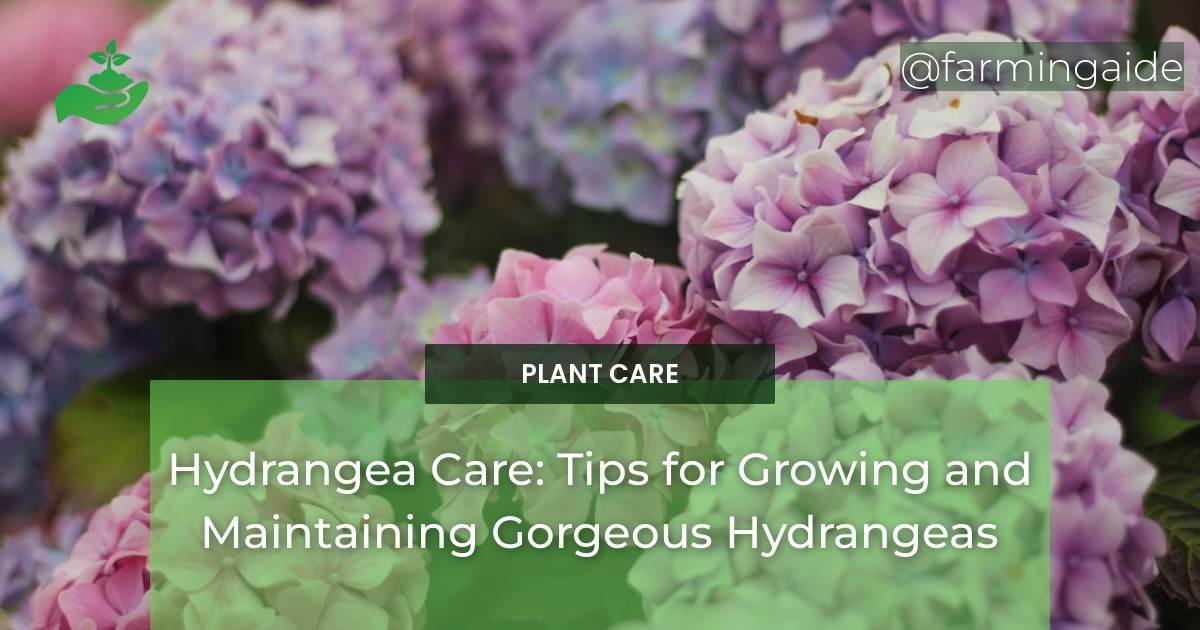Hydrangeas are beloved for their stunning and vibrant blooms, making them a popular choice among gardeners. However, growing and maintaining these gorgeous flowering plants requires proper care and attention. Whether you’re a beginner or an experienced gardener, this comprehensive guide will provide you with valuable tips and insights for successfully cultivating hydrangeas.
Introduction to Hydrangeas and their Beautiful Blooms
Hydrangeas are deciduous shrubs that belong to the Hydrangeaceae family. They are native to Asia and the Americas and are known for their large, showy flower heads. These blooms come in a variety of colors, including pink, blue, purple, and white, adding a touch of elegance and charm to any garden.
Understanding the Different Hydrangea Varieties and their Care Requirements
There are several hydrangea varieties, each with its unique characteristics and care needs. Some popular varieties include:
- Bigleaf hydrangeas (Hydrangea macrophylla)
- Panicled hydrangeas (Hydrangea paniculata)
- Smooth hydrangeas (Hydrangea arborescens)
- Oakleaf hydrangeas (Hydrangea quercifolia)
- Climbing hydrangeas (Hydrangea anomala petiolaris)
It’s essential to understand the specific requirements of each variety to ensure optimal growth and blooming.
Soil Preparation and Planting Techniques for Hydrangeas
Choosing the Right Soil for Hydrangeas
The soil composition plays a crucial role in the health and growth of hydrangeas. These plants thrive in well-draining soil that is rich in organic matter. Ideally, the soil pH should be slightly acidic to neutral.
Improving Soil Drainage for Hydrangeas
Hydrangeas are susceptible to root rot if the soil retains too much moisture. To improve drainage, amend the soil with organic matter, such as compost or peat moss. Additionally, planting hydrangeas in raised beds or mounds can help prevent waterlogging.
Planting Hydrangeas for Optimal Growth
When planting hydrangeas, choose a location that receives partial shade or filtered sunlight. Dig a hole that is twice the size of the plant’s root ball and backfill it with amended soil. Ensure that the crown of the plant is level with or slightly above the ground surface.
Watering and Fertilizing Hydrangeas for Optimal Growth
Proper Watering Techniques for Hydrangeas
Hydrangeas require regular watering, especially during hot and dry periods. It’s important to keep the soil consistently moist but not waterlogged. Deep watering once or twice a week is generally sufficient, allowing the top inch of soil to dry out between waterings.
Understanding Hydrangea Fertilizer Requirements
Applying fertilizer can enhance the growth and blooming of hydrangeas. Before fertilizing, it’s crucial to understand the specific nutrient needs of your hydrangea variety. A soil test can help determine the deficiencies and guide you in selecting the appropriate fertilizer.
Applying Fertilizer to Hydrangeas
When applying fertilizer, follow the instructions on the package carefully. Generally, it’s best to fertilize hydrangeas in early spring before new growth emerges. Avoid overfertilizing, as it can lead to excessive foliage growth at the expense of blooms.
ALSO READ
Pruning and Shaping Hydrangeas for Desired Form
When to Prune Hydrangeas
The pruning timing depends on the hydrangea variety. Bigleaf and oakleaf hydrangeas bloom on old wood, so they should be pruned immediately after flowering. Panicled and smooth hydrangeas bloom on new wood and can be pruned in late winter or early spring before new growth begins.
Pruning Techniques for Different Hydrangea Varieties
Each hydrangea variety requires specific pruning techniques to maintain its shape and promote healthy growth. For bigleaf and oakleaf hydrangeas, selectively remove old stems to encourage new growth. Panicled and smooth hydrangeas can be pruned more extensively to control their size and shape.
Shaping Hydrangeas for Aesthetic Appeal
If you desire a particular form or size for your hydrangeas, regular pruning and shaping are necessary. Prune the branches selectively to create a balanced and aesthetically pleasing shape. Remember to step back and assess the plant’s appearance as you prune.
Dealing with Common Hydrangea Problems and Diseases
Identifying and Treating Hydrangea Pests
Hydrangeas can fall victim to various pests, including aphids, spider mites, and slugs. Regular inspection of the leaves and blooms can help identify pest infestations early. Utilize organic or chemical insecticides as necessary, following the instructions carefully.
Preventing and Managing Hydrangea Diseases
Hydrangeas are susceptible to diseases such as powdery mildew, leaf spot, and root rot. To prevent these diseases, ensure proper air circulation around the plants and avoid overhead watering. Prune and discard infected plant parts to prevent the spread of diseases.
Are Hydrangeas and Boston Ferns Similar in Their Care Needs?
When it comes to how to care for Boston ferns and hydrangeas, they do have some similar care needs. Both plants require regular watering to keep the soil consistently moist. Additionally, they thrive in well-draining soil and enjoy regular pruning to maintain their shape and health.
Tips for Changing the Color of Hydrangea Blooms
Understanding Factors that Influence Hydrangea Bloom Color
The color of hydrangea blooms can be influenced by various factors, including soil pH and the presence of aluminum ions. Acidic soil (pH below 6) tends to produce blue blooms, while alkaline soil (pH above 7) results in pink blooms.
Tips for Achieving Blue or Pink Hydrangea Blooms
To achieve blue hydrangea blooms, lower the soil pH by applying aluminum sulfate or sulfur. For pink hydrangea blooms, increase the soil pH by adding lime or wood ash. It’s important to note that the availability of aluminum in the soil also affects bloom color.
Other Methods to Alter Hydrangea Bloom Color
Aside from adjusting soil pH, there are other methods to alter the color of hydrangea blooms. These include using color-changing varieties, applying color-enhancing products, or even temporarily dyeing the blooms using safe, plant-friendly dyes.
By following these tips and implementing proper care techniques, you can enjoy the beauty of hydrangeas in your garden year after year. With their stunning blooms and lush foliage, these plants are sure to be the highlight of any landscape.


